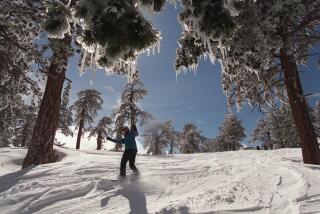The view from above Los Angeles
When I tell people I live in California, they almost always ask where. But when they hear Los Angeles, all too often their faces fall. They were hoping, I suspect, for Sausalito or Pebble Beach.
To them Los Angeles is a place of flat, seemingly endless streets, mini-malls wreathed in smog and choking traffic. We all know what they mean.
But there’s another way to view the city.
A few days ago I hiked to the top of Mt. Lowe, 5,600 feet above sea level, with the entire Los Angeles basin spreading out beyond. Without traffic, you can get from downtown to the trail head in under an hour.
As I stood on the peak, one of my 17-year-old twins was getting ready to drive on some of those overcrowded roads to the Hollywood Bowl. When I first saw that amphitheater in a Frank Sinatra movie, it looked as noble as its predecessors in Athens or Delphi. But when I finally visited it decades later, with a hamper of food and wine to hear Beethoven’s Ninth and watch the sunset in perfect weather, the Bowl seemed to have an edge over both of them.
As I stood on my peak, the other twin was kayaking off Catalina Island, which was clearly visible. It too seems like something out of the Mediterranean, our version of Capri, the place the Roman Emperor Tiberius chose as the best place in the whole empire when he went into voluntary exile. As Capri is to Naples, Catalina is to Los Angeles, just a short hop across an azure sea.
Meanwhile, my wife was scouring the garment district as the costumer for a small opera company that is only possible because of the abundance of singing and acting talent that floods to Southern California from every country in the world. She is able to pick up fabrics and costumes for a song, like the pants worn by Jack Nicholson in “Batman,” which she bought at an auction for $3.
Yet behind me was total wilderness. Empty of all human life, the chaparral-covered slopes rise as steep or steeper than the angle of repose, through terrain that is virtually impenetrable except for the fire road I had walked up and a network of hiking trails. The land is so dry that only the toughest vegetation can survive, yet not far away, for several months a year, the snow on Mt. Baldy can be blinding.
Mt. Wilson, almost close enough to touch, has a telescope that once could peer more deeply into space than any other. Now its scientific prowess has been overtaken, but the nearby Jet Propulsion Laboratory in La Cañada Flintridge has sent probes into space that brought Mars into living rooms around the world. As a result, science and technology studies in the local public schools are a strong suit.
And scientific subjects aren’t the schools’ only strengths. When my twins were in middle school, one of the English teachers assured the parents: “At the end of the school year, your children will like Shakespeare. Money back guaranteed.” As far as I know, she was never required to pay up.
Farther away, to the left of where I stood, purple peaks marked the beginning of a vast desert that stretches for hundreds of miles. To the right were the mountains chosen for their remoteness to be a haven for bringing the California condor back from the edge of extinction. All this was in one view.
None of the other largest cities in the world comes anywhere near having this variety on its doorstep. Ours, like all the others, is struggling. But it’s hard to resist the paraphrase: “Whoever is tired of Los Angeles is tired of life.”
Reg Green is a Los Angeles writer. https://www.nicholasgreen.org
More to Read
A cure for the common opinion
Get thought-provoking perspectives with our weekly newsletter.
You may occasionally receive promotional content from the Los Angeles Times.






